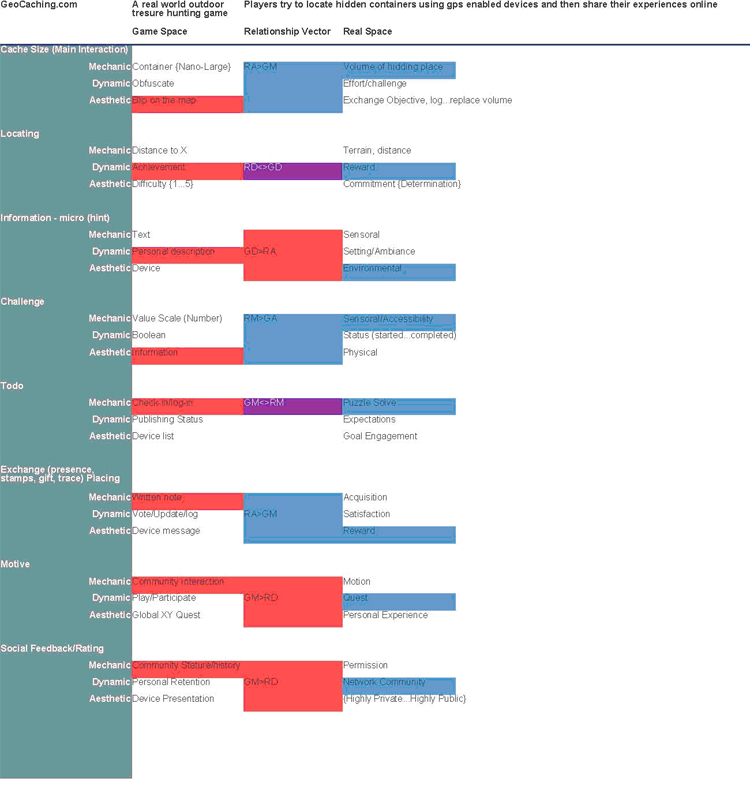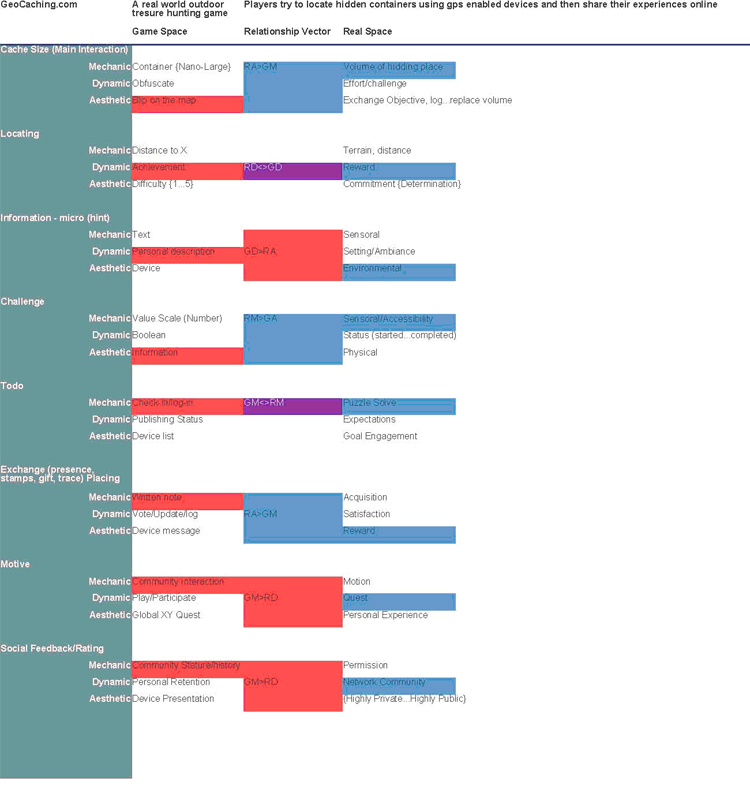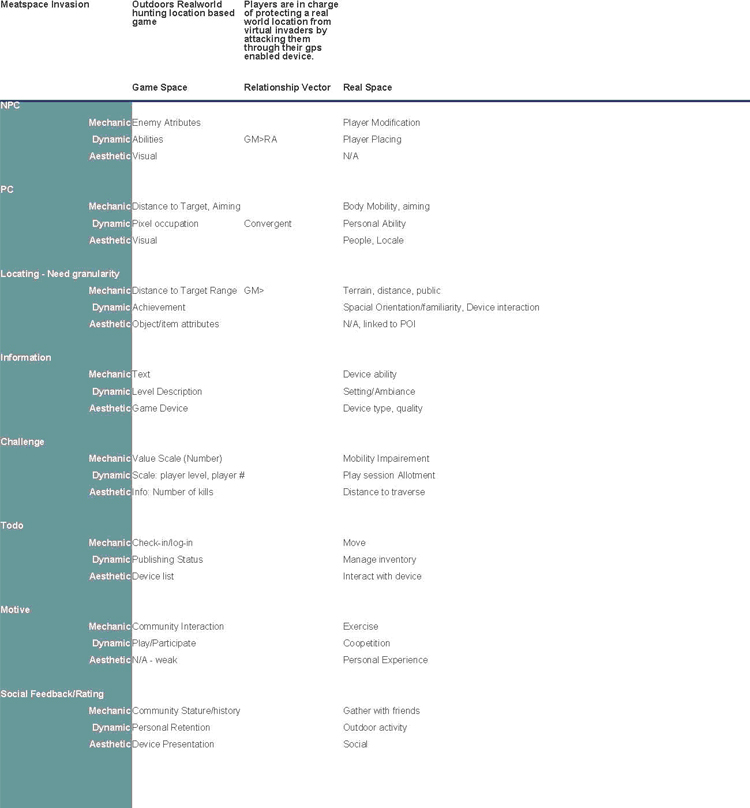|
To present a working understanding of the variety of considerations for the design and development of location-based games by industry professionals. Our purpose is to help this field of development become commercially successful because we believe that this type of game needs a “killer app” to establish its mass appeal.
Using an interactive technology-based position-finding system in conjunction with an application on the same device which entertains the user in the form of an engaging and intuitive game that is directly affected by the user’s location.
To expand the audience for and popularity of location-based gaming using the player’s location as a compelling mechanic to attract players to the game and promote an understanding of the advantages and disadvantages of location-based game development.
What you need to know to plan the development of your game and consider when determining the scope of the design.
- Development Tools: Platform-specific APIs, Unity, Google Map API, and others are low-cost or free and easily available through each platform’s SDK or the developer website. APIs require some technical integration to use effectively.
- Hardware: Mobile platforms including iPhone, Android, and others. Applications can be created in C++/Objective C, Java, HTML5, Cocoa, and Javascript, depending on the target platform. A webserver is required for any persistent multiplayer gameplay.
- Location Information: Open Street Map (www.openstreetmap.org) provides points of interest, street data, and location type and is the only free option available at this time.
- Scale: The Earth is 148,940,000 km2; Azeroth is 113 km2. Unless you are making a locale-specific game, you will need to consider the potentially global scope of the gameplay area, or ignore scale in its entirety (and consequently real maps).
- Procedural Generation: Due to the scale issues mentioned, content for persistent world-spanning games must be generated procedurally based on commonalities rather than customized for the player.
- Market Research: There are a lot of unknowns as this market has not been developed commercially with great success and remains niche. Barriers to entry and development are low but poorly defined.
- Monetization: Inclusion of sponsored locations (e.g., retail or restaurant chains), related equipment (such as exercise gear or clothing), and advertising games (made specifically for locations like Disney) are all valid non-consumer ways to generate revenue, in addition to models like retail, fremium, and subscription.
Large-scale issues to consider when designing location-based games.
- Unfamiliarity: Lack of understanding by game developers of the game development concepts specific to location-based games.
- Interface: Lack of knowledge about how the location of the device allows the player to interact with the game.
- 2D: Lack of a third dimension (altitude / vertical space) in what would seem to be an otherwise three-dimensional world (the real world).
- Legal Issues: Distraction, danger (driving, running, walking, etc.), risks related to push notifications (stalking, robbery, etc.).
- Be prepared for potential litigation (particularly if you are first in this space) by having a comprehensive EULA written by a lawyer.
- Discovery: Since the market doesn’t yet exist, it works against new games by making it difficult for players to find the game.
Issues that interfere with the player’s ability to play location-based games.
- Unfamiliarity: Lack of knowledge of location-based games leaves the user with no basis for understanding the integrated game environment.
- Movement: Players don’t realize initially that their movement affects the gameplay, leaving the user confused and increasing the barrier to entry.
- Distraction: The player’s attention is split between the real world and game activity, degrading their ability to participate fully in both the real and virtual worlds. Solutions may include having separate movement and activity phases or specific time for planning strategy in which the player does not move.
- Disabilities: Lack of applicability of location-based games to persons with certain movement-related disabilities (although this brings up the further opportunity to create location-based games specifically for those with movement disabilities).
- Shyness: The natural resistance of people to meeting strangers in person; a means of social acceptance is needed to counteract this.
Factors to understand in planning for games in which reality is a primary contributor to the player’s experience.
- Player: The player is the controller, cursor, and avatar in the game.
- Interactions: The real and virtual spaces must interact on some level.
- Complexity: Managing complexity of integration and level of detail so that the player can balance their attention to the real and virtual worlds.
- Meta: Meta-experiences can be derived from an integrated reality (for example, text drafting, in which a person follows closely behind another person in a crowd so they can focus on texting rather than moving through the group).
Why we might want to play location-based games.
- Fitness: Games focusing on exercise for health improvement.
- Social Interaction: In theory, games can be designed to promote interaction between players who may or may not know each other personally.
- Competition: Comparing achievements/scores between players to reward success and grade players against live opponents.
- Exploration: Games that involve travel, discovery, or movement around a region without another additional or more important gameplay purpose.
- Serious Games: Training simulations for teaching specific, practical skills to groups of professionals working in the same field.
- Entertainment: Location-based games as fun and interesting.
- Novelty: Location-based games as a new experience.
Some categories of games that focus on location-based parameters.
- Trekking: Move from one point to another, possibly bringing and/or taking something from locations or moving on to another location.
- Active: Physical activity is integral to gameplay and a part of the experience.
- Exercise: Constant physical activity is the goal of gameplay.
- Race: Time, movement, and speed are integral to gameplay.
- Territory: Gameplay includes capturing, fighting over, or occupying a physical location in virtual space.
- Sim: A game of complex creation with other players, such as a garden, farm,, castle, minefield, etc. in real space using virtual tools.
The game’s way of convincing the player to do what it wants you to do.
- Location: Distance from game resources and relative positions of objects, players, and goals within the game structure.
- Aiming: Includes aspects of facing, firing, range, and location of target.
- Movement: Going to and from objects, goals, and players; may use a map, compass, or a virtual overlay of the physical space for guidance.
- Placement: Finding, caching, hiding, collecting, and storing objects in ways like farming, mining, espionage, archaeology, etc.
- Socialization: Reward players for collocated play (synchronous / asynchronous).
- Matchmaking: Creating cooperation, competition, lobbies, informal (dynamic) queuing, drop in/out, distance as a modifier.
- Economy: Transferring objects, points, or money between local players and/or the game’s economic structure.
Various tidbits of information that can be gathered and analyzed to determine achievements, player activities, and pain points that can be used to iterate design.
- Distance traveled
- Speed (average / top)
- Calories used
- Players interacted with
- Locations visited
- Objects collected
- Points scored
- Time played
https://docs.google.com/spreadsheet/ccc?key=0AiWYVbZH1HINdEtpOHM0N1J2LXZuRGZCUXlidEI2ZlE
http://en.wikipedia.org/wiki/Location-based_game
http://mashable.com/2011/07/24/location-based-gaming/
http://www.wired.com/geekdad/2010/02/own-your-world-with-location-based-mobile-games/
http://playaslife.com/2011/07/17/ideas-for-location-based-games-a-potential-for-social-gamification/



section 7
|
